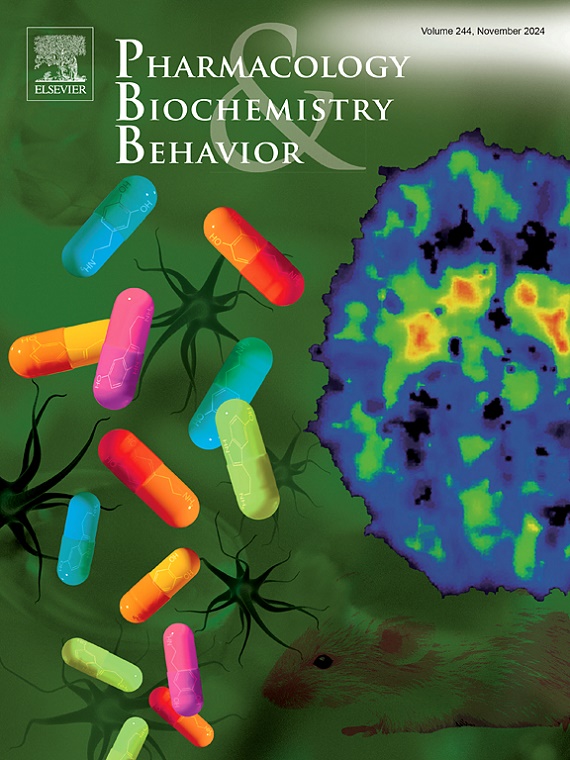长通道和短通道可卡因会改变雄性大鼠对可卡因的行为抑制。
IF 3.3
3区 心理学
Q1 BEHAVIORAL SCIENCES
引用次数: 0
摘要
冲动和行为抑制通常与药物滥用有关,特别是可卡因使用障碍。然而,根据可卡因使用历史和可卡因依赖程度的不同,冲动行为的模式也有所不同。与有限的可卡因获取相比,延长可卡因获取时间更接近于模拟可卡因使用问题发展过程中发生的神经和行为变化,已被证明可以减少行为抑制。然而,之前研究这些关系的临床前研究大多是相关的,并且只利用非药物奖励。本研究旨在利用差异低强化率(DRL)计划来研究长期接触可卡因对可卡因强化物行为抑制的影响。雄性Sprague Dawley大鼠首先按照DRL强化计划自行静脉注射可卡因,然后分成两组:一组给予6小时延长可卡因摄入(LgA),一组给予1小时短可卡因摄入(ShA),每天10次。经过一段洗脱期后,大鼠被重新置于DRL可卡因自我管理阶段。结果显示,LgA大鼠在DRL自我给药期间的行为抑制表现与基线DRL表现和ShA获取后行为抑制表现相比有所下降。这些结果表明,长期接触可卡因会损害机体对未来可卡因使用的行为抑制,这表明那些有大量可卡因使用史的个体对未来可卡因使用的行为抑制会受损。本文章由计算机程序翻译,如有差异,请以英文原文为准。
Long- vs short-access cocaine alters behavioral inhibition for cocaine in male rats
Impulsivity and behavioral inhibition are measures commonly associated with substance misuse, particularly cocaine use disorder. However, patterns of impulsive behaviors have been shown to differ based on cocaine use history and level of cocaine dependence. Extended cocaine access, which more closely models neural and behavioral changes that take place during the development of problematic cocaine use, has been shown to decrease behavioral inhibition in comparison to limited cocaine access. However, previous preclinical studies investigating these relationships have been mostly correlational and only utilize non-drug rewards. This study aims to utilize a differential rates of low reinforcement (DRL) schedule to investigate the impact of extended access to cocaine on behavioral inhibition toward a cocaine reinforcer. Male Sprague Dawley rats first self-administered intravenous cocaine infusions on a DRL schedule of reinforcement before being split into two groups: one given 6-h extended cocaine access (LgA) and one given 1-h short cocaine access (ShA) for 10 daily sessions. Following a washout period, the rats were placed back on DRL cocaine self-administration sessions. Results revealed that LgA rats showed impaired performance on the behavioral inhibition measure during the DRL self-administration sessions compared to baseline DRL performance and compared to ShA post-access behavioral inhibition measures. These results indicate that extended cocaine access impairs an organism's behavioral inhibition toward future cocaine use, indicating that those individuals with a history of heavy cocaine use will have impaired behavioral inhibition toward future cocaine use.
求助全文
通过发布文献求助,成功后即可免费获取论文全文。
去求助
来源期刊
CiteScore
6.40
自引率
2.80%
发文量
122
审稿时长
38 days
期刊介绍:
Pharmacology Biochemistry & Behavior publishes original reports in the areas of pharmacology and biochemistry in which the primary emphasis and theoretical context are behavioral. Contributions may involve clinical, preclinical, or basic research. Purely biochemical or toxicology studies will not be published. Papers describing the behavioral effects of novel drugs in models of psychiatric, neurological and cognitive disorders, and central pain must include a positive control unless the paper is on a disease where such a drug is not available yet. Papers focusing on physiological processes (e.g., peripheral pain mechanisms, body temperature regulation, seizure activity) are not accepted as we would like to retain the focus of Pharmacology Biochemistry & Behavior on behavior and its interaction with the biochemistry and neurochemistry of the central nervous system. Papers describing the effects of plant materials are generally not considered, unless the active ingredients are studied, the extraction method is well described, the doses tested are known, and clear and definite experimental evidence on the mechanism of action of the active ingredients is provided.

 求助内容:
求助内容: 应助结果提醒方式:
应助结果提醒方式:


